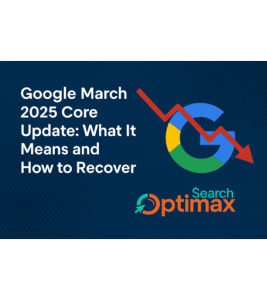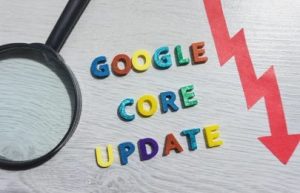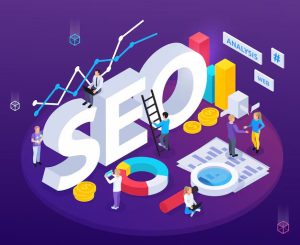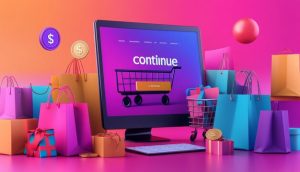Top Ecommerce Website Design Trends in 2025

As the digital landscape continues to evolve, eCommerce websites must keep pace with new trends and innovations to stay competitive. In 2025, creating an optimized eCommerce website goes beyond aesthetics. It’s about creating a seamless, accessible, and engaging user experience that drives conversions.
User Experience (UX) & User Interface (UI)
In 2025, designing for the user is paramount. Companies must focus on providing intuitive interfaces, personalized experiences, and enhanced accessibility for all users, including those with disabilities. Accessibility features are essential not only to improve the UX but also to comply with legal requirements and extend your website’s reach to a broader audience.
Accessibility: Why It Matters More Than Ever
In 2025, accessibility is no longer just an option—it’s a necessity. Accessibility ensures that all users, regardless of their abilities or disabilities, can navigate and interact with an eCommerce site. As laws like the Americans with Disabilities Act (ADA) gain enforcement, businesses are expected to create websites that are WCAG (Web Content Accessibility Guidelines) compliant, improving accessibility for visually impaired, hearing impaired, or mobility-limited users.
i. WCAG Compliance
WCAG compliance refers to following a set of guidelines established by the World Wide Web Consortium (W3C) to make websites accessible to everyone. Websites must adhere to WCAG standards to ensure accessibility across all platforms and devices.
For instance, WCAG recommends:
- Providing text alternatives for non-text content
- Ensuring web pages can be navigated without a mouse (for users with mobility issues)
- Using clear, simple language
ii. Screen Reader Optimization
For visually impaired users, screen readers are essential tools that read out text on a webpage. Optimizing eCommerce websites for screen readers ensures that all customers can understand product details, descriptions, and instructions. Implementing proper semantic HTML elements, ARIA (Accessible Rich Internet Applications) labels, and alt-text for images enhances the experience for these users.
While many people use a mouse or touchscreen to navigate websites, users with mobility impairments may rely on a keyboard or assistive devices. Websites must be designed to ensure that all interactive elements (like buttons, links, and forms) can be easily accessed via keyboard. This is especially important in eCommerce, where adding products to the cart, checking out, and entering payment information all require smooth, keyboard-friendly navigation.
iv. Color Contrast
Color contrast is an often overlooked but crucial element of accessibility. Websites should use sufficient color contrast between text and background to ensure readability, particularly for users with color blindness or low vision. Tools like the WCAG Contrast Checker can help you test the contrast ratios and ensure compliance.
Personalization in Ecommerce Websites
1- AI-Powered Recommendations
Artificial Intelligence (AI) is transforming the way eCommerce websites understand and cater to individual customer preferences. In 2025, AI-powered recommendations will play an even more significant role in enhancing the personalization of eCommerce experiences.
How It Works:
AI algorithms analyze vast amounts of data, such as customer behavior, browsing history, past purchases, and demographic information, to deliver highly relevant product recommendations. These recommendations can be displayed on the homepage, product pages, and checkout screens, encouraging customers to explore products that align with their tastes.
Benefits of AI-Powered Recommendations:
- Increased sales: By suggesting products that customers are likely to purchase, AI-driven recommendations drive higher conversion rates.
- Enhanced customer experience: Personalized recommendations make it easier for customers to find products they’ll love, which leads to improved satisfaction.
- Better inventory management: AI can help predict demand for products and ensure popular items are in stock.
2 – Dynamic Content
Dynamic content allows websites to adapt their content based on customer preferences, behavior, or location in real-time. This highly personalized approach provides users with content that is directly relevant to them, improving engagement and encouraging conversion.
How It Works:
Dynamic content can take many forms, including personalized banners, targeted offers, or tailored product collections that change based on the user’s interactions. For example, a returning visitor might see a banner showcasing new products from their favorite category, or a first-time user might receive a welcome offer for signing up.
Benefits of Dynamic Content:
- Higher engagement: Relevant content encourages users to interact more with the site, exploring products and offers that suit their interests.
- Increased conversion rates: By showing the right products or promotions to the right people, dynamic content can significantly boost conversion rates.
- Improved customer loyalty: When customers see content that speaks to their specific interests, they’re more likely to return and make repeat purchases.
3- Customer Segmentation
Customer segmentation is the process of dividing your audience into smaller groups based on shared characteristics such as demographics, purchase behavior, or interests. In 2025, eCommerce websites will increasingly use sophisticated segmentation strategies to create more personalized shopping experiences.
How It Works:
Customer segmentation allows businesses to tailor the user experience to specific groups. For example, one segment may receive targeted email campaigns based on their previous purchase history, while another segment might see different product recommendations based on their browsing behavior.
Benefits of Customer Segmentation:
- Better-targeted marketing: Segmentation allows businesses to send relevant promotions, offers, and content to the right audience at the right time.
- Increased ROI: Tailored marketing campaigns typically see better performance, resulting in a higher return on investment.
- Enhanced customer satisfaction: When customers feel that the content and offers they receive are specifically for them, they are more likely to engage and make purchases.
4 – Behavioral Targeting
Behavioral targeting involves analyzing user behavior, such as browsing history, clicks, and time spent on specific pages, to deliver tailored content and offers. In 2025, behavioral targeting will be one of the most powerful tools for personalization in eCommerce.
How It Works:
By tracking a user’s actions on the website, such as the pages they visit, the products they click on, and the items they add to their cart, businesses can create personalized experiences. For example, if a customer frequently browses shoes but hasn’t yet made a purchase, the website might show them a special promotion or discount for shoes.
Benefits of Behavioral Targeting:
- Increased conversion: By showing users offers based on their interests and behavior, businesses can encourage them to make purchases.
- Better retention: Personalized experiences keep customers coming back for more, reducing bounce rates and improving long-term customer loyalty.
- Smarter marketing: Behavioral targeting provides valuable insights into customer preferences and can inform future marketing strategies.
Key Personalization Features for Ecommerce Websites in 2025
| Personalization Feature | Description | Benefits |
| AI-Powered Recommendations | Use of artificial intelligence to suggest products based on customer behavior and preferences. | Increases sales, enhances user experience, and improves inventory management. |
| Dynamic Content | Content that adapts in real-time to the user’s behavior, location, or preferences. | Boosts engagement, improves conversion rates, and fosters loyalty. |
| Customer Segmentation | Dividing customers into groups based on shared traits to provide tailored experiences. | Delivers better-targeted marketing, improves ROI, and enhances customer satisfaction. |
| Behavioral Targeting | Tracking and analyzing user behavior to show relevant content and offers. | Drives conversions, enhances retention, and improves marketing effectiveness. |
Mobile-First Design for Ecommerce Websites
A. Responsive Design
Responsive design ensures that a website adjusts seamlessly to different screen sizes and devices, providing an optimal viewing experience for users on mobile phones, tablets, and desktops. With mobile-first design, responsive layouts are essential to ensure that your eCommerce website is accessible to all users, regardless of the device they are using.
How It Works:
Responsive design uses flexible grids, images, and CSS media queries to adjust the layout of a website based on the size of the user’s screen. For mobile users, this often means simplifying the design by resizing elements, rearranging content, and making navigation more intuitive.
Benefits of Responsive Design:
- Improved user experience: Visitors on mobile devices will enjoy a smooth, seamless browsing experience with content that adapts to their screen.
- Better SEO performance: Google prioritizes mobile-friendly websites in search results, meaning responsive design can boost your site’s visibility.
- Cost-effective: One responsive site works across all devices, reducing the need for separate designs or maintenance for mobile and desktop versions.
B. Mobile-Specific Features
In 2025, eCommerce websites will integrate more mobile-specific features to enhance the shopping experience for users on smartphones. These features are designed to leverage the unique capabilities of mobile devices, improving usability, speed, and engagement.
Key Mobile-Specific Features:
- One-click payments: Features like Apple Pay, Google Pay, or mobile wallet integration make it easy for users to complete transactions quickly without needing to enter payment details manually.
- Location-based services: Geolocation features allow businesses to deliver personalized offers, promotions, or product recommendations based on the user’s physical location.
- Push notifications: Mobile push notifications keep users engaged with real-time updates, new product launches, or personalized offers directly on their mobile devices.
- Voice search: With the rise of voice assistants, eCommerce websites must integrate voice search functionality, allowing users to find products using voice commands.
Benefits of Mobile-Specific Features:
- Enhanced convenience: Features like one-click payments streamline the purchasing process, increasing conversion rates.
- Increased engagement: Push notifications and location-based offers keep users engaged, encouraging them to return and complete purchases.
- Improved user retention: By providing a mobile-optimized experience, users are more likely to return and make future purchases.
C. Accelerated Mobile Pages (AMP)
Accelerated Mobile Pages (AMP) is a technology designed to speed up the loading time of mobile web pages. With mobile users often expecting pages to load in under three seconds, AMP helps ensure your eCommerce website performs efficiently on mobile devices.
How It Works:
AMP simplifies the structure of web pages, removing unnecessary code and using a streamlined version of HTML. It prioritizes speed by limiting JavaScript usage, allowing pages to load quickly, even on slower networks or less powerful devices.
Benefits of AMP:
- Faster load times: Faster loading speeds improve the user experience, especially for mobile users, leading to lower bounce rates.
- Better SEO rankings: Google favors websites that load quickly, and AMP-optimized pages can improve your site’s search engine ranking.
- Increased conversions: Faster page load times reduce the chances of customers abandoning their carts or leaving before making a purchase.
D. Progressive Web Apps (PWAs)
Progressive Web Apps (PWAs) are web applications that offer a mobile-app-like experience directly in the browser. PWAs combine the best features of websites and mobile apps, making them an excellent choice for eCommerce websites in 2025.
How It Works:
PWAs are built using standard web technologies, but they can be installed on a user’s device and accessed like native apps. They work offline, load quickly, and provide push notifications—features that make the experience more like using a mobile app without the need to download anything from an app store.
Benefits of PWAs:
- App-like experience: PWAs offer a fast, seamless, and engaging experience that mimics mobile apps, leading to better user engagement.
- Offline functionality: Users can continue browsing and shopping even when they have no internet connection, improving accessibility.
- Cost-effective: PWAs eliminate the need to develop separate iOS and Android apps, saving both time and money.
- Higher engagement: Features like push notifications and home screen installation drive user retention and repeat visits.
Visual Design & Aesthetics
As eCommerce continues to evolve, visual design and aesthetics play an increasingly important role in creating memorable, engaging, and user-friendly websites. In 2025, design trends are moving towards simplicity, clarity, and creativity—ensuring that users are not only able to navigate websites effortlessly but also enjoy visually pleasing and immersive experiences
Visual Design & Aesthetics in Ecommerce Websites
A. Minimalism
Minimalism in web design has become a staple for eCommerce websites in recent years. In 2025, minimalism will continue to dominate as brands seek to provide clean, intuitive designs that focus on what matters most to the user. Minimalist websites are easier to navigate, faster to load, and more visually appealing, all of which contribute to a better shopping experience.
i. Clean Layouts
A clean layout ensures that the website’s structure is simple and organized, eliminating unnecessary clutter. For eCommerce websites, this means arranging products, categories, and calls to action in a straightforward manner that enhances the user’s ability to quickly find what they need.
How It Works:
- Simplified grid systems that focus on clarity and easy navigation
- Reduced clutter with minimal distractions or non-essential elements
- Clear and intuitive placement of key actions (e.g., add to cart, checkout buttons)
Benefits:
- Improves user experience by making it easy to browse and shop
- Faster load times due to fewer design elements and heavy images
- Better accessibility for users with visual impairments or cognitive challenges
ii. White Space
White space, also known as negative space, refers to the empty space between elements on a webpage. It’s an essential component of minimalist design because it gives users visual breathing room and helps guide their focus to the most important content.
How It Works:
- Allowing sufficient space around images, buttons, and text to prevent the page from feeling crowded
- Using empty space to create a sense of balance and hierarchy between elements
- Focusing attention on key product details or calls to action (CTAs)
Benefits:
- Improves readability and reduces visual overload
- Increases focus on the key elements that drive conversion (e.g., product images, prices, CTAs)
- Creates a clean and sophisticated look that elevates the overall user experience
iii. Focus on Key Elements
Minimalist design places an emphasis on key elements, such as product images, descriptions, and calls to action. The aim is to guide the user’s attention to what matters most without distractions.
How It Works:
- Prioritizing high-quality product images and minimal text for clarity
- Using strategic positioning and visual hierarchy to highlight important features or offers
- Simplifying navigation menus and search features for ease of use
Benefits:
- Boosts conversion by directing users’ focus towards actions like purchasing or signing up
- Increases engagement by reducing cognitive load and overwhelming visual stimuli
- Improves mobile responsiveness, as minimalism is ideal for smaller screens
iv. Simple Typography
Typography plays an essential role in minimalist design. In 2025, eCommerce websites will continue to embrace simple, legible fonts that enhance the clarity and overall feel of the design.
How It Works:
- Using sans-serif fonts or clean typefaces that are easy to read on all devices
- Limiting the number of font types to maintain consistency
- Choosing fonts that reflect the brand’s identity while remaining neutral and unobtrusive
Benefits:
- Enhances readability and user experience
- Creates a modern, professional, and user-friendly interface
- Ensures consistency across various pages and devices
B. Bold Typography
In 2025, bold typography will emerge as a key visual design trend in eCommerce. As websites become more dynamic and focused on grabbing users’ attention, large and bold typography is being used to make powerful statements and create memorable brand experiences.
i. Large, Eye-Catching Fonts
Using large, bold fonts for headings and key messages will help grab the attention of website visitors. These fonts can be used to highlight important offers, promotions, or product categories, ensuring they stand out to users.
How It Works:
- Large fonts for headlines, promotional banners, and key messages
- Using contrasting colors for added emphasis and visual impact
- Ensuring text is legible across all screen sizes and devices
Benefits:
- Instantly captures user attention and helps with brand recognition
- Communicates key messages clearly and effectively
- Enhances the visual hierarchy and overall design flow
ii. Custom Fonts
Custom fonts are becoming increasingly popular as brands seek to create unique identities and differentiate themselves in a crowded market. These fonts are designed specifically for the brand’s website and can help convey personality and tone.
How It Works:
- Developing or selecting fonts that align with the brand’s personality, whether it’s playful, sophisticated, or modern
- Combining custom fonts with minimalist design principles for an effective aesthetic
- Ensuring compatibility across all devices and screen resolutions
Benefits:
- Creates a distinctive visual identity that reinforces brand personality
- Improves user engagement by making the website stand out
- Enhances the overall aesthetic by providing a cohesive design language
iii. Typography as a Design Element
Typography can be more than just a tool for communication; it can also function as a design element. Bold typography is being used creatively as a focal point in the design, making it a central part of the overall aesthetic.
How It Works:
- Using large, impactful fonts as part of the visual composition on product pages, homepages, and category pages
- Integrating typography into animations or transitions to keep users engaged
- Incorporating typographic elements as artistic features (e.g., background text or overlay effects)
Benefits:
- Adds an artistic, creative flair to the website’s design
- Encourages users to interact with content, making the experience more engaging
- Strengthens the overall brand experience through visually appealing text elements
iv. Brand Consistency
Bold typography can also help maintain brand consistency across all marketing channels. In 2025, websites will use typography as a tool to reinforce brand identity and maintain a cohesive look across various platforms.
How It Works:
- Aligning font styles and sizes with the brand’s visual guidelines
- Using the same typography for social media, print, and digital marketing to create a unified presence
- Incorporating typographic elements into all promotional material and content
Benefits:
- Strengthens brand recognition and recall
- Ensures consistency across different platforms, creating a seamless experience
- Helps create a cohesive, professional image for the brand
Key Visual Design Features
| Design Feature | Description | Benefits |
| Clean Layouts | Simplified website structure with organized elements for easy navigation. | Enhances user experience, improves usability, and boosts conversions. |
| White Space | Empty space between design elements that enhances focus and readability. | Reduces clutter, improves attention to key elements, and elevates design. |
| Focus on Key Elements | Prioritizing important content such as products and CTAs to guide the user’s attention. | Increases conversion by highlighting essential features. |
| Simple Typography | Using clean, legible fonts that enhance clarity and readability. | Improves user experience and ensures brand consistency. |
| Large, Eye-Catching Fonts | Bold, large typography used for headlines, promotions, and key messages. | Captures user attention and communicates key messages effectively. |
| Custom Fonts | Unique, brand-specific fonts that create a distinctive visual identity. | Enhances brand recognition and differentiates from competitors. |
| Typography as a Design Element | Using typography creatively as a visual element in the overall design. | Adds artistic flair and keeps the website visually engaging. |
| Brand Consistency | Consistent typography usage across all platforms to reinforce brand identity. | Strengthens brand recognition and provides a cohesive experience. |
3D & AR/VR Integration
Augmented Reality (AR) and Virtual Reality (VR) have made huge strides in the eCommerce industry, allowing users to experience products in more immersive and engaging ways. By incorporating 3D product visualization and AR/VR features, eCommerce websites can elevate the shopping experience and reduce friction in the buying process.
i. Product Visualization
In 2025, 3D product visualization will allow users to interact with products like never before. Instead of relying solely on static images, customers will be able to rotate, zoom, and view products from all angles, making them feel more confident in their purchasing decisions.
How It Works:
- Customers can explore products in 3D, examining fine details that may not be visible in traditional 2D photos.
- Interactive 3D models allow users to view product variants (colors, sizes) and even customize aspects of the product.
Benefits:
- Improves customer confidence by providing a more realistic view of the product.
- Increases engagement by allowing users to interact with products before purchasing.
- Reduces product returns, as customers have a clearer understanding of what they’re buying.
ii. Augmented Reality Experiences
AR allows users to overlay digital elements, like products, into their real-world environment through their smartphones or other devices. This offers a deeper level of interaction and helps customers visualize how products will fit into their lives.
How It Works:
- Users can virtually place furniture in their living room or try on clothes through the screen of their mobile device.
- Brands can offer in-app AR experiences where users can see how products look in real-time.
Benefits:
- Enhances the shopping experience by enabling customers to see products in their own environment.
- Helps reduce uncertainty in purchasing decisions, particularly for items like furniture, clothing, and accessories.
- Drives higher engagement and time spent on the website or app.
iii. Virtual Try-On
Virtual try-on technology is a game-changer for the fashion, beauty, and eyewear industries. This technology uses AR and facial recognition to allow users to virtually try on clothes, accessories, and makeup products without the need to visit a physical store.
How It Works:
- Using a smartphone or webcam, users can see how a pair of shoes, a piece of jewelry, or even a new shade of lipstick looks on them in real-time.
- This technology can be integrated into eCommerce websites or mobile apps for a seamless virtual try-on experience.
Benefits:
- Increases conversion rates by helping users make confident purchasing decisions.
- Reduces returns due to incorrect fit or style choices.
- Offers a unique, immersive shopping experience that builds brand loyalty.
iv. Interactive 3D Models
Interactive 3D models allow users to manipulate and interact with products in more detail than static 3D renderings. These models can be used for everything from high-end electronics to clothing and accessories.
How It Works:
- Users can zoom, rotate, and even customize products with real-time interactions.
- For example, an interactive 3D model of a car or a piece of jewelry might let the user change the color, add custom features, or view different product angles.
Benefits:
- Provides a deeper, more immersive shopping experience.
- Enhances engagement, leading to increased sales and brand awareness.
- Allows customers to make more informed purchasing decisions with dynamic interaction.
D. Video Marketing
In 2025, video marketing will continue to be one of the most powerful tools for eCommerce brands. Videos provide a more dynamic way to showcase products, tell brand stories, and connect with consumers. By integrating videos into their websites, eCommerce businesses can increase engagement, foster trust, and build a deeper connection with customers.
i. Product Demo Videos
Product demonstration videos will become a standard feature on eCommerce websites in 2025. These videos allow potential buyers to see how products work, learn about key features, and understand their benefits in action.
How It Works:
- Videos can showcase the product in use, highlight key functionalities, or compare it to competitors.
- For complex products, demo videos provide an easy way to explain how the product works.
Benefits:
- Improves customer understanding of the product, leading to higher conversion rates.
- Reduces returns by clarifying product details and usage.
- Increases trust in the brand by providing clear and informative content.
ii. Brand Storytelling Videos
Brand storytelling videos help companies connect with consumers on an emotional level by sharing their mission, vision, and values. These videos can include customer testimonials, behind-the-scenes footage, and even personal stories that resonate with viewers.
How It Works:
- Companies produce videos that convey their brand’s values, culture, and ethos.
- These videos can feature customer testimonials, showing real people using and benefiting from the products.
Benefits:
- Builds stronger emotional connections with the brand, fostering customer loyalty.
- Differentiates the brand in a competitive market.
- Increases trust by showing the human side of the business.
iii. User-Generated Content Videos
User-generated content (UGC) is content created by customers or fans of the brand, such as unboxing videos, reviews, or testimonials. Incorporating UGC into eCommerce websites helps build social proof and authenticity.
How It Works:
- Encourage customers to share videos of their experiences with the product or service.
- Feature these videos on product pages or social media to build community engagement.
Benefits:
- Increases brand credibility by showcasing real customer experiences.
- Builds trust and social proof, encouraging new customers to make purchases.
- Fosters a sense of community and connection around the brand.
iv. Live Video Streaming
Live video streaming allows brands to connect with their audience in real-time, showcasing products, answering customer questions, and offering exclusive promotions. Live streams are gaining popularity for product launches, Q&A sessions, and even live sales events.
How It Works:
- Brands host live events on their website or social media platforms, allowing customers to interact directly with the brand in real-time.
- Live shopping events can feature live product demos, behind-the-scenes footage, and flash sales.
Benefits:
- Increases engagement by enabling direct communication with the audience.
- Drives impulse purchases through exclusive promotions during live events.
- Creates a sense of urgency and excitement around product launches.
E. Interactive Elements
Interactive elements in eCommerce web design are designed to enhance the user experience by making the website more engaging and fun. In 2025, interactivity will play a crucial role in driving user engagement and increasing time spent on site.
i. Animations
Animations bring websites to life, adding a dynamic layer of interaction. These animations can be used to highlight products, draw attention to key elements, or simply make the browsing experience more enjoyable.
How It Works:
- Animated transitions, hover effects, or product showcases add a layer of interactivity.
- Elements such as buttons or images may animate when clicked, providing feedback to the user.
Benefits:
- Increases engagement by making the website feel interactive and lively.
- Enhances the user experience by providing visual cues and feedback.
- Improves brand perception by showing a modern, innovative approach.
ii. Hover Effects
Hover effects are interactive design elements that respond when a user hovers their mouse over an object on the screen. These effects can reveal more information, display a different view of a product, or add animations.
How It Works:
- When users hover over an image or button, it might change color, animate, or display additional content (like a zoom feature for product images).
Benefits:
- Enhances user engagement by adding subtle yet impactful interactions.
- Improves user navigation by providing visual cues and previews.
- Adds an extra layer of interactivity that increases dwell time on the website.
iii. Micro-Interactions
Micro-interactions are small, subtle interactions that respond to user input. These can include notifications, like a heart icon filling in when a product is added to the wishlist or a loading animation while content is being displayed.
How It Works:
- Small animations or responses that indicate that something has occurred (e.g., clicking a “like” button or adding an item to the cart).
- These can provide real-time feedback and help users understand how they are interacting with the website.
Benefits:
- Makes the website feel more intuitive and responsive.
- Enhances user satisfaction by providing immediate feedback to actions.
- Increases user engagement with playful and interactive features.
iv. Gamification
Gamification incorporates game-like elements, such as rewards, achievements, or challenges, to engage users. By offering points or rewards for completing specific actions (like sharing or purchasing), brands can make the shopping experience more fun.
How It Works:
- Users might earn loyalty points, unlock discounts, or receive badges for interacting with the website.
- Competitions, quizzes, or challenges can be integrated to drive customer interaction.
Benefits:
- Increases user engagement by making the shopping experience more enjoyable.
- Encourages users to take desired actions (e.g., completing a purchase or sharing content).
- Builds brand loyalty by rewarding customers for their interactions.
Summary of Key Trends
| Trend | Description | Benefits |
| 3D Product Visualization | Allows users to interact with products in 3D, zooming and rotating to view all angles. | Improves confidence in purchasing, reduces returns, enhances engagement. |
| AR Experiences | Augments real-world environments with digital products via mobile devices. | Helps visualize products in real-life contexts, reduces uncertainty. |
| Virtual Try-On | Users can try on products virtually, such as clothes or makeup, using AR technology. | Increases conversion, reduces returns, and provides immersive experiences. |
| Interactive 3D Models | Users can customize and interact with 3D models of products in real-time. | Increases engagement, provides deeper interaction. |
| Product Demo Videos | Videos that show the functionality and features of products. | Improves customer understanding, boosts conversion, reduces returns. |
| Brand Storytelling Videos | Videos that convey the brand’s values, vision, and mission, building emotional connections. | Builds trust, fosters loyalty, enhances brand image. |
| User-Generated Content Videos | Videos created by customers showcasing their experiences with products. | Builds authenticity, provides social proof, increases trust. |
| Live Video Streaming | Real-time video broadcasts showcasing products, promotions, or Q&A sessions. | Increases engagement, drives impulse purchases, and builds excitement. |
| Animations | Dynamic animations that bring the website to life. | Enhances user experience, increases engagement, modernizes design. |
| Hover Effects | Interactive elements that respond when users hover over them. | Improves navigation, adds interactivity, engages users. |
| Micro-Interactions | Small animations or feedback that respond to user actions. | Enhances satisfaction, makes the experience intuitive. |
| Gamification | Integrating game-like features such as rewards and challenges into the shopping experience. | Boosts engagement, incentivizes desired actions, builds loyalty. |
FAQs
1. What are the key eCommerce design trends for 2025?
The key trends for 2025 include 3D & AR/VR integration, video marketing, and interactive elements. These technologies are being used to enhance product visualization, engage customers, and create immersive shopping experiences that boost conversions and customer satisfaction.
2. How can AR and VR improve the eCommerce shopping experience?
AR and VR technologies allow users to visualize products in their real-world environments or try them out virtually, helping customers make more informed purchasing decisions. This reduces uncertainty, increases confidence, and minimizes returns.
3. What is the role of video marketing in eCommerce websites?
Video marketing plays a crucial role in engaging customers through product demos, brand storytelling, user-generated content, and live streaming. Videos create an emotional connection, increase trust, and boost conversions by providing clear, engaging, and interactive content.
4. Why are interactive elements important in eCommerce design?
Interactive elements such as animations, hover effects, and micro-interactions make websites more engaging and dynamic. These features improve user experience, encourage exploration, and create a more memorable shopping experience, ultimately leading to higher conversion rates.
5. How does gamification benefit eCommerce businesses?
Gamification involves integrating game-like features such as rewards, points, and challenges into the shopping experience. This boosts user engagement, motivates customers to take desired actions (like completing a purchase), and fosters long-term loyalty.
6. How can 3D product visualization help increase eCommerce sales?
3D product visualization allows customers to view products from multiple angles and zoom in on details, providing a more realistic and interactive shopping experience. This enhances customer confidence, reduces uncertainty, and can lead to higher conversion rates.
7. Are AR/VR features only useful for certain industries in eCommerce?
While AR/VR technologies are most commonly used in industries like fashion, furniture, and cosmetics, they can benefit any eCommerce website by providing an immersive, interactive experience. These features help customers visualize products in real-time, making them useful across a wide range of industries.
8. What is the impact of user-generated content (UGC) videos on eCommerce websites?
User-generated content videos build social proof by showcasing real customers using and enjoying products. UGC fosters trust and authenticity, encouraging new customers to make purchases based on positive experiences shared by others.
9. What can eCommerce businesses do to stay competitive in 2025?
To stay competitive, eCommerce businesses should embrace cutting-edge technologies like AR/VR, integrate engaging video content, and use interactive design elements. These strategies will help them provide immersive, personalized shopping experiences that meet the demands of modern consumers.
10. How can businesses measure the effectiveness of these design trends?
Businesses can track key metrics such as conversion rates, bounce rates, user engagement, and customer feedback to measure the success of implementing these design trends. A/B testing and user experience research are also valuable tools to assess the impact of these innovations on overall site performance.
Conclusion
In conclusion, embracing the latest eCommerce website design trends is crucial for staying competitive in 2025. These trends not only enhance user experience but also foster deeper customer engagement, trust, and loyalty—ultimately driving success in the evolving eCommerce landscape.







